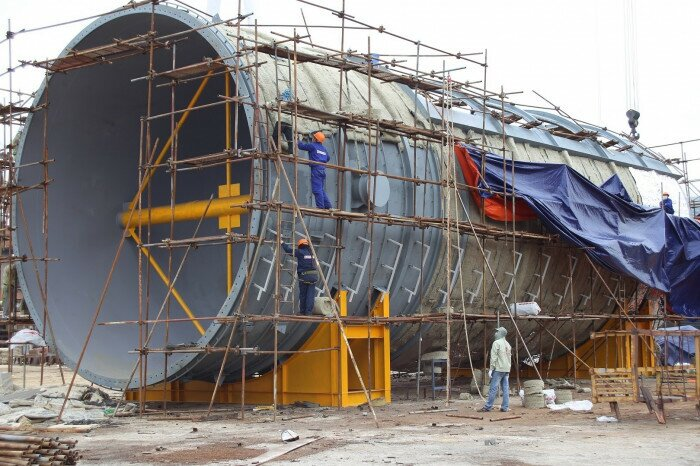Maritime infrastructure develops strongly, attracting “huge” investment capital
14/04/2023Maritime infrastructure has undergone drastic changes after implementing the master plan on the seaport system to 2020, with a vision to 2030.
Forming gateway ports combined with international transshipment
The Ministry of Transport has just sent a document to Deputy Prime Minister Tran Hong Ha and the Prime Minister on the finalization of the detailed planning for groups of seaports, ports, wharves, floating terminals, water zones and waters in the 2021-2030 period and vision to 2050.
The average growth of goods through seaports nationwide will reach 8.4%/year in the period 2017 – 2021
According to the Ministry of Transport, implementing the master plan on the seaport system by 2020, with a vision to 2030, approved and adjusted by the Prime Minister, maritime infrastructure has made strong progress.
Specifically, the gateway ports combined with international transshipment have been established in the North (Hai Phong) and the South (Ba Ria – Vung Tau). The ports are invested in depth, applying science and technology, so the throughput exceeds the design capacity. Particularly, there is Cat Lai port area with 1.3 – 1.5 design capacity.
By 2020, the freight transport market share of the maritime sector will account for 23.17% of the whole industry compared to the target set out in the Vietnam Transport Development Strategy to 2020, with a vision to 2035 of 9-14%. (over 166 – 257%). The average growth of goods through seaports nationwide is 8.4%/year in the period 2017 – 2021.
Maritime is also the only sector to grow in the 5 transport sectors in 2020 despite the impact of the Covid-19 pandemic. The total volume of goods through the seaport in 2020 will reach 692.2 million tons, compared with the planned target of 640-680 million tons (about 8.4 times higher than in 2000), achieving a growth rate of 13.3% per year in the period. year 2015 – 2020.
In which, the growth of container cargo in the period 2017-2021 reached 3.5% in tons (lower than the overall cargo growth of 8.36%) and 9.91% in terms of Teu for dry goods (general cargo, bulk cargo) grew by 15.34%.
The whole country has established 34 transport routes, including 11 intra-Asia routes, 3 routes to Europe, 20 routes to the Americas, outperforming Southeast Asian countries (only after Malaysia and Singapore).
According to the report “Port Performance Index 2021” (CPPI 2021) of the World Bank and the financial news agency S&P Global Market Intelligence, Cai Mep port cluster is ranked 11th out of a total of 370 ports/container terminal clusters operating. Global best performance (according to the average statistical calculation of 5 ship size groups) – 38 places higher than 2020 and ranked 13th in the “administrative approach” index (in technical terms, giving higher weights) for common vessel sizes at that port) – up 5 places compared to 2020. Besides Cai Mep port cluster, Vung Tau port in Vietnam also ranked 37/370 in technical terms.
More than 173,000 billion in non-budget investment for maritime
As of October 2022, the country has 296 ports, about 107 km in length (5 times more than in 2000). At the same time, international gateway ports have been established in the northern and southern regions, as well as successfully receiving container ships up to 145,000 tons at Lach Huyen wharf area (Hai Phong), up to 214,000 tons at Cai Mep wharf area. (BA Ria Vung Tau).
Specialized ports are also developed and receive many large vessels. Large-scale specialized berths associated with industrial parks, metallurgical complexes, refineries and petrochemicals, coal-fired thermal power centers receive ships up to 200,000 tons, liquid cargo up to 150,000 tons (product ships), and crude oil arriving at 320,000 tons, basically achieved the planning targets by 2020.
Notably, in the development of the maritime sector, investment capital comes from the State budget and mobilized from outside the budget.
According to the Ministry of Transport, with open investment policies, over the past time, Vietnam’s seaports have attracted enterprises to invest in seaports. Investors are professional port operators, major shipping lines of the world. investors involved in the construction, operation and exploitation of ports.
As a result, the investment capital for the period 2011 – 2020 is about 202 trillion VND, accounting for about 20.6% of the total investment capital for transport infrastructure.
In which, the non-budget capital mobilized for investment in the maritime sector is about 173.4 trillion VND, approximately 86% of the total investment capital.
From here, the Ministry of Transport emphasized that the implementation of technical and specialized plans to concretize the Master Plan for the development of the seaport system is essential for the synchronous and continuous development of the seaport system in the master plan, meeting the requirements of industrialization and modernization of the country.
At the same time, bringing our country deep integration and competitiveness in seaport activities with countries in the region and the world, contributing to ensuring national defense and security.
Source: Bao Giao thong
Must Read
You may be interested in


Priority is given to investing in 29 seaport projects with a total capital of over 31 trillion Vietnamese Dong sourced from the state budget

Ba Ria – Vung Tau to become national marine economic hub

Improving the capacity of shipbuilding enterprises, catching the wave of opportunities

Completing negotiations and signing power purchase agreements with 40/40 transitional renewable energy investors

Vietnam expected to emerge as a prominent logistics player in Asia

Freight transportation from Ho Chi Minh City port to Barion Head port

Ho Chi Minh City orients to develop Can Gio “superport”

The maritime industry strives for green transformation








